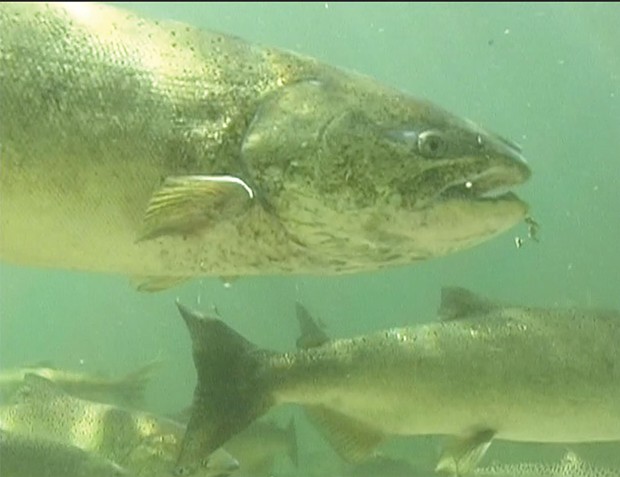News Blog

- Photo by Nathaniel Pennington
- A spring run Chinook in the Salmon River, a tributary to the Klamath.
"It’s devastating for our community," said Karen Greenberg, restoration director for the Salmon River Restoration Council in a press release. "We have worked tirelessly for decades to protect and restore this fishery but it may be slipping away from us unless we act decisively to save them.”
The annual Salmon River Cooperative Spring Chinook and Summer Steelhead Population Snorkel Survey has taken place since 1994, recording tallies of spring Chinook ranging from 90 to 1,600, with this year's tally marking the second lowest total returned in two decades, and a third consecutive year marking new second-lowest totals.
“It’s like watching a loved one on life support," said Karuk Tribal Chair Russell "Buster" Attebery. "We won’t stop fighting for them.”
While removal of four hydroelectric dams that currently clog the river is slated to begin in 2023, opening up hundreds of miles of spawning habitat and improving water quality, salmon continue to suffer the cumulative impacts of climate change, hydraulic mining, irrigation diversions and large canneries, as well as sediment from road building and logging. The Karuk Tribe is calling for the reintroduction of traditional fishery management practices — like erecting picket-fence like structures in the rivers at certain times of year to help separate the spring and fall Chinook runs to preserve their genetic diversity.
"We are optimistic that plans to remove Klamath River dams in 2023 will help, but we will have to do more to recover these fish from such low numbers," said Karuk Natural Resources Director Bill Tripp in the release. "We will have to look back to the old ways for more immediate solutions.”
The tribe and the restoration council successfully petitioned the California Fish and Game Commission to add Upper Klamath Trinity Spring Chinook to the state's endangered species list just last month, which is hoped will bring additional funding for restoration projects.
For more information, read the full press release copied below:
KLAMATH SPRING CHINOOK CREEPS CLOSER TO EXTINCTION
Historically the Klamath’s Largest Run, Spring Chinook Numbers at Record Lows…again
Somes Bar, CA - The population of Chinook salmon that swims up the Klamath River in the spring once numbered in the hundreds of thousands. Last week, divers at the Salmon River Cooperative Spring Chinook and Summer Steelhead Population Snorkel Survey only 95 Spring Chinook, which is the second lowest return counted in over 20 years, and the third year in a row of second lowest numbers. The Salmon River cooperative dive surveys have occurred every year since 1994, and have ranged from 90 to 1,600 spring Chinook salmon, with an average of over 650 fish.
“It’s devastating for our community. We have worked tirelessly for decades to protect and restore this fishery but it may be slipping away from us unless we act decisively to save them,” said Karuna Greenberg, Restoration Director, Salmon River Restoration Council.
The Karuk Tribe’s aboriginal territory includes a large portion of the Salmon River and Spring Chinook were a staple in the Karuk diet for millennia. “It’s like watching a loved one on life support. We won’t stop fighting for them,” said Karuk Chairman Russell ‘Buster’ Attebery.
Spring Chinook were once the most abundant fish in the Klamath Basin, with hundreds of thousands of fish returning to the river each year to spawn. They thrived in the headwater streams of the Klamath and Trinity, in tributaries over 250 miles or more from the sea and over 4,000 feet of elevation. However, since the influx of non-native settlers beginning in the late 19th century, Spring Chinook suffered precipitous declines due to hydraulic mining, irrigation diversions, large canneries, sediment from road building and logging, and dams. The majority of the West Coast’s spring Chinook habitat was lost following the construction of dams such as those on the Klamath, Shasta, and Trinity Rivers.
“We are optimistic that plans to remove Klamath River dams in 2023 will help, but we will have to do more to recover these fish from such low numbers. We will have to look back to the old ways for more immediate solutions,” noted Karuk Natural Resources Director Bill Tripp.
Tripp points out that some waterfalls and rapids served to separate spring and fall runs of Chinook. In the spring, when waters are high, Spring Chinook can pass through rapids that Fall Chinook, migrating later on lower flows, can’t navigate. This allowed the populations to segregate and preserve genetic diversity. “Well intentioned settlers and governing agencies blasted many of these selective barriers, allowing fall fish to spawn with spring fish, undermining the genetic diversity,” explained Tripp.
Traditional management strategies and ceremonies also involved construction of picket fence like weirs once the spring run had traveled past a certain point, also to protect the genetic integrity of the spring run. “It’s time to bring back these practices to give ishyaat a chance to recover,” concluded Tripp, using the Karuk word for Spring Chinook.
The Tribe and the SRRC successfully petitioned California Fish and Game Commission to add Upper Klamath Trinity Spring Chinook to the State Endangered Species list just last month. “We hope that listing will lead to funding for restoration and monitoring programs, but this year’s tragic return underscores the fact that we need to do everything in our power to save these fish before its too late. That means we need to consider re-establishing their reproductive isolation.” said Greenberg.
The cooperative annual survey is coordinated by the Salmon River Restoration Council with collaboration from members of local tribes, the Forest Service, NOAA Fisheries, California Department of Fish and Wildlife, Watershed Councils and Community Volunteerism. The survey involves teams of counters snorkeling downstream for 3-4 mile stretches and covers over all 80 miles of river in one day. This survey is likely the longest running data set of this kind for salmon in the Pacific Northwest.
Comments